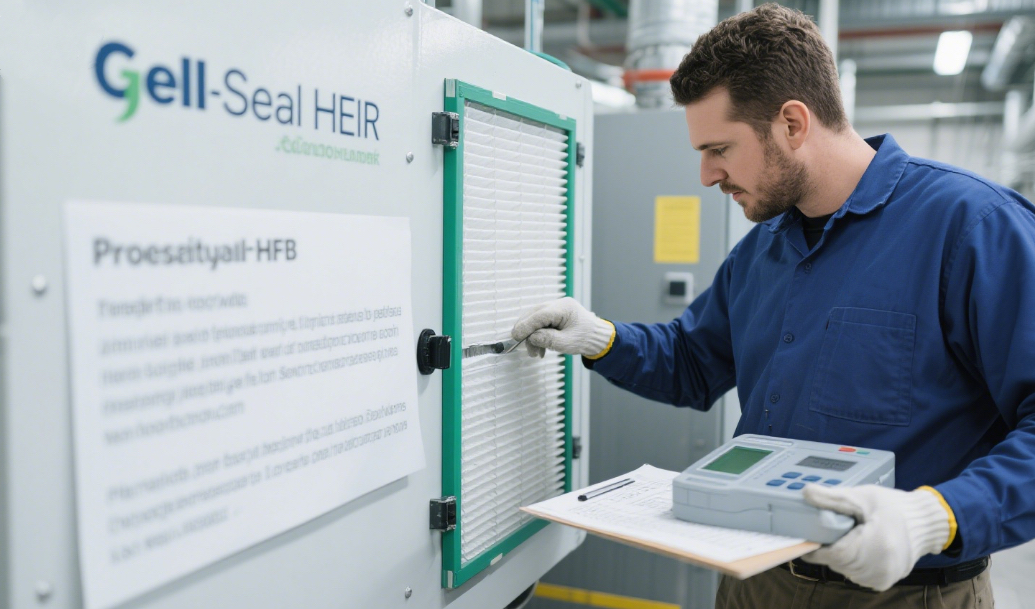On-Site Testing and Technical Services for Gel Seal HEPA Filters
The on-site testing and technical services for Gel Seal HEPA filters are the ultimate and essential steps to ensure their successful installation and long-term reliable operation. The core of this technical service is the on-site leak test, which aims to verify the integrity of the filter itself, its liquid seal interface with the installation frame, and the entire installation perimeter, ensuring there are no leakage points.
I. Testing Objectives and Importance
1. Objective:To visually confirm and locate any leaks in the Gel Seal HEPA filter and its installation system, ensuring the air quality of the clean environment meets the design grade (e.g., ISO 5/Class 100).
2. Importance:
- Quality Verification: A mandatory step for installation project acceptance, proving the success of the installation.
- Risk Control:Preventing the entire clean environment from failing due to micro-leaks, which is a safety baseline for biosafety laboratories and semiconductor fabs.
- Performance Assurance: Ensuring the production yield of products, the accuracy of experiments, or the safety of operations.
- Liability Allocation: Clarifying the responsibilities for installation issues and product quality issues.
II. Testing Method: PAO/DOP Aerosol Photometry Scan Leak Detection
This is the most commonly used and authoritative quantitative detection method.
1. Working Principle
- Upstream Smoke Generation: In the supply air plenum or duct, a specialized generator produces PAO (Polyalphaolefin) or DOP (Di-2-ethylhexyl phthalate) aerosol particles (typically 0.3-0.5μm) and mixes them uniformly in the airflow.
- Downstream Scanning:Using a high-sensitivity photometer probe on the downstream side of the filter (i.e., the cleanroom side), the probe scans all areas slowly and overlappingly at a distance of about 1-2cm from the filter surface, with a speed of <5cm/s.
- Real-time Measurement: The probe continuously draws air samples, and the photometer measures the aerosol concentration. Any leakage point will cause a sharp increase in downstream concentration, triggering an alarm and displaying the leakage rate (e.g., 0.01%).
2. Scanning Areas
- Filter Media Surface: Checking for holes or defects in the filter itself.
- Bonding between Filter Media and Frame: Checking the sealing process of the filter.
- Liquid Seal Interface (the Most Critical Scanning Area): Scanning the entire interface between the filter knife edge and the installation frame’s liquid seal, which is the most prone to installation leaks.
- Connections between Frames: Checking the overall sealing of the installation frames.
- Connections between Frame and FFU/Deck:** Checking the sealing integrity of the entire supply air unit.
III. Technical Service Process
A professional on-site testing service typically includes the following steps:
1. Preparation
- Confirm Site Conditions: The HVAC system has been running continuously for at least 12 hours and is stable, and the cleanroom has been thoroughly cleaned.
- Equipment Calibration: Calibrate the aerosol generator and high-sensitivity photometer to ensure accurate data.
- Plan Formulation: Confirm the testing scope, standards (e.g., ISO 14644-3), and pass criteria with the client.
2. On-Site Operations
- Smoke Generation Setup: Establish a stable aerosol concentration in the plenum or duct (e.g., 10-20μg/L).
- Baseline Measurement: Measure the upstream aerosol baseline concentration.
- Downstream Scanning: Two technicians work together to scan each filter and all interfaces comprehensively along a predetermined path. The probe movement should be slow and steady.
- Leak Marking: Immediately mark any detected leakage points with non – shedding adhesive tape.
3. Problem Analysis and Repair
- Cause Analysis: Determine whether the leak is due to a filter defect, liquid seal adhesive filling issue, uneven frame, or insufficient mechanical clamping.
- On-Site Repair:
- For Installation Issues: Minor leaks can be attempted to be repaired with specialized adhesive; severe leaks may require removing the filter, cleaning old adhesive, and re – installing with new adhesive.
- For Product Issues: Replace with a new spare filter.
- Re – Testing: All repaired points must be re – scanned until fully qualified.
4. Report and Delivery
- Generate a detailed Chinese test report, typically including:
- Testing Standards and Methods.
- Instrument Models and Serial Numbers.
- Filter Numbers, Locations, and Scan Results (Maximum Leakage Rate).
- Locations, Photos, and Repair Records of Non – Conforming Points.
- Conclusion: Clearly state whether the installation area passes the leak test and meets the XX standard/grade.
- Report Interpretation: Explain the report content to the client’s responsible person and file it for future maintenance reference.
IV. Acceptance Criteria
Typically referenced from ISO 14644-3 or GB/T 25915 standards:
For HEPA/ULPA filters, the leakage rate at any point must not exceed 0.01% of the upstream concentration (i.e., for a filter with 99.99% efficiency, the leakage point must not exceed 0.01%). More stringent projects may require a leakage rate of <0.005%.
V. How to Choose a Technical Service Provider
1. Qualifications and Experience: Select a third – party testing institution with CNAS (China National Accreditation Service for Conformity Assessment) or CMA (Certification and Accreditation of Testing Institutions) qualifications. Inquire about their experience with similar projects, especially liquid seal systems.
2. Equipment Level: Use high – precision, high – sensitivity photometers (e.g., ATI, MetOne) that are within the regular calibration validity period.
3. Personnel Professionalism: Operators should be trained and familiar with the structure of liquid seal systems and common leakage points, able to accurately diagnose leakage causes and provide repair suggestions.
4. Service Scope: Confirm whether the service includes technical guidance or assistance in repairs after issues are found, not just testing and reporting.
The on – site testing and technical services for Gel Seal HEPA filters are not a simple “test” but a systematic quality verification and problem – diagnosis process. It is the last and most crucial firewall to ensure that the high – investment clean environment functions as expected. Do not omit or perform this test perfunctorily to save costs.





Post time: Sep-09-2025


